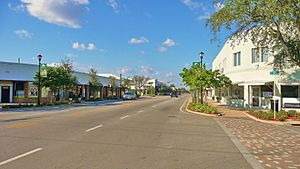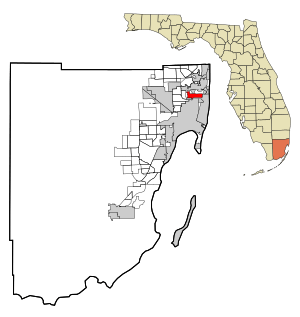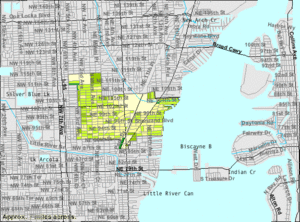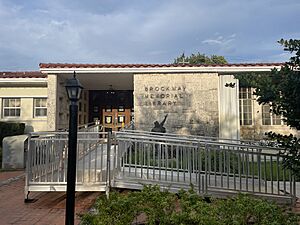Miami Shores, Florida facts for kids
Quick facts for kids
Miami Shores, Florida
|
||
|---|---|---|
| Miami Shores Village | ||

Downtown Miami Shores
|
||
|
||
| Nickname(s):
The Shores
|
||
| Motto(s):
Viventes In Sole
|
||

Location in Miami-Dade County and the state of Florida
|
||

U.S. Census Bureau map showing village boundaries
|
||
| Country | ||
| State | ||
| County | ||
| Incorporated | January 2, 1932 | |
| Government | ||
| • Type | Council-Manager | |
| Area | ||
| • Total | 3.78 sq mi (9.79 km2) | |
| • Land | 2.49 sq mi (6.44 km2) | |
| • Water | 1.29 sq mi (3.35 km2) | |
| Elevation | 7 ft (2 m) | |
| Population
(2020)
|
||
| • Total | 11,567 | |
| • Density | 4,650.99/sq mi (1,795.97/km2) | |
| Time zone | UTC-5 (EST) | |
| • Summer (DST) | UTC-4 (EDT) | |
| ZIP Codes |
33138, 33150, 33153, 33161, 33168
|
|
| Area code(s) | 305, 786, 645 | |
| FIPS code | 12-45175 | |
| GNIS feature ID | 0286760 | |
Miami Shores or Miami Shores Village is a small town, called a village, located in Miami-Dade County, Florida. It's part of the larger Miami metropolitan area in South Florida. In 2020, about 11,567 people lived there, which was more than the 10,493 people in 2010.
Contents
History of Miami Shores
Early Days and Development Plans
In the early 1900s, the land that is now Miami Shores was used for farming. People grew pineapples and grapefruit, and there were mills for starch and wood. Early settlers like Major Hugh Gordon and T.V. Moore were successful farmers. In 1922, a wealthy person named Lee T. Cooper bought T.V. Moore's land. He planned to build a community called "Bay View Estates."
Later, in 1924, a company called Shoreland Company bought more land, including Bay View Estates. They wanted to create a new community called Miami Shores, which they called "America's Mediterranean." The Shoreland Company had experience building other successful areas, like the Venetian Islands in Miami Beach. They planned for Miami Shores to have Italian-style homes and be surrounded by water.
Building the Community and Challenges
The Shoreland Company had big plans for Miami Shores. They wanted to build 9,000 homes, create miles of waterfront, and add canals. Their plans also included a causeway (a raised road over water) to Miami Beach, a golf course, clubs, shops, hotels, schools, and churches. They also planned for parks and beautiful entryways.
The company built 118 fancy Mediterranean-style homes. Many of these homes are still important today, and 25 of them are listed on the National Register of Historic Places. Roads and sidewalks were being built, and the area was becoming very popular. However, on September 18, 1926, a very strong hurricane hit Miami. This storm, along with other problems, caused the Shoreland Company to go bankrupt in 1927.
A New Beginning for Miami Shores
In 1928, a new company called New Miami Shores Corporation bought the land. This company was run by Bessemer Properties. Roy H. Hawkins, who managed Bessemer Properties, continued with the plans for the community. He is known as the main founder of Miami Shores.
In 1931, under his leadership, a request was made to officially create Miami Shores Village. The area that is now Miami Shores used to be part of the city of Miami. During the Great Depression, Miami gave up control of this area. So, on January 2, 1932, Miami Shores Village officially became its own town.
The first council members included Hugh H. Gordon, whose father owned some of the original land, and other important local figures. Frank O. Pruitt was chosen as the first mayor.
Modern Miami Shores
After it became official, Miami Shores grew steadily. Different styles of buildings were added over the years. Today, Miami Shores still has many of its original features. It has tree-lined streets, wide roads, a downtown area, and well-kept homes.
Miami Shores is mostly a bedroom community. This means many people who live there travel to work in the larger Miami metropolitan area. It also has many retired people. Most of the homes are single-family houses, with only a few apartment buildings. There are two small shopping areas along Northeast 2nd Avenue and Biscayne Boulevard.
Even though people often call it Miami Shores, its official name is Miami Shores Village.
Geography of Miami Shores
Miami Shores is located in the northeastern part of Miami-Dade County. It is next to Biscayne Park to the north and El Portal to the southwest. To the south is the city of Miami. On its eastern side is Biscayne Bay, and across the bay is Miami Beach.
The village covers a total area of about 3.78 square miles (9.79 square kilometers). About 2.49 square miles (6.44 square kilometers) of this is land, and 1.29 square miles (3.35 square kilometers) is water. This means about 34% of the village's area is water.
Population and People
| Historical population | |||
|---|---|---|---|
| Census | Pop. | %± | |
| 1930 | 612 | — | |
| 1940 | 1,956 | 219.6% | |
| 1950 | 5,086 | 160.0% | |
| 1960 | 8,865 | 74.3% | |
| 1970 | 9,425 | 6.3% | |
| 1980 | 9,244 | −1.9% | |
| 1990 | 10,084 | 9.1% | |
| 2000 | 10,380 | 2.9% | |
| 2010 | 10,493 | 1.1% | |
| 2020 | 11,567 | 10.2% | |
| U.S. Decennial Census | |||
Population in 2020
In 2020, Miami Shores had 11,567 people living in 3,117 households.
| Race | Number | Percentage |
|---|---|---|
| White (NH) | 4,243 | 36.68% |
| Black or African American (NH) | 2,072 | 17.91% |
| Native American or Alaska Native (NH) | 12 | 0.10% |
| Asian (NH) | 288 | 2.49% |
| Pacific Islander or Native Hawaiian (NH) | 5 | 0.04% |
| Some other race (NH) | 66 | 0.57% |
| Two or more races/Multiracial (NH) | 421 | 3.64% |
| Hispanic or Latino | 4,460 | 38.56% |
| Total | 11,567 |
Population in 2010
In 2010, there were 10,493 people living in Miami Shores.
| Miami Shores Demographics | |||
|---|---|---|---|
| 2010 Census | Miami Shores | Miami-Dade County | Florida |
| Total population | 10,493 | 2,496,435 | 18,801,310 |
| Population, percent change, 2000 to 2010 | +1.1% | +10.8% | +17.6% |
| Population density | 4,191.9/sq mi | 1,315.5/sq mi | 350.6/sq mi |
| White or Caucasian (including White Hispanic) | 49.1% | 73.8% | 75.0% |
| (Non-Hispanic White or Caucasian) | 42.1% | 15.4% | 57.9% |
| Black or African-American | 23.8% | 18.9% | 16.0% |
| Hispanic or Latino (of any race) | 30.6% | 65.0% | 22.5% |
| Asian | 2.6% | 1.5% | 2.4% |
| Native American or Native Alaskan | 0.3% | 0.2% | 0.4% |
| Some Other Race | 2.3% | 3.2% | 3.6% |
In 2010, the largest groups of Hispanic and Latino people were from Cuba (33.41%), South America (25.97%), and Puerto Rico (11.48%).
Between 2012 and 2016, about 40% of people in Miami Shores spoke a language other than English at home. Also, nearly half of the adults had a college degree or higher. The average household income was about $101,047. About 6.5% of the population lived below the poverty line.
Schools and Learning
Public Schools
Miami-Dade County Public Schools runs the public schools that serve Miami Shores:
- Miami Shores Elementary School
- Horace Mann Middle School
- Miami Edison High School (located in Miami)
Other Schools in Miami Shores
Several other public, charter, and private schools are located right in Miami Shores:
- Miami Shores Elementary School
- Doctors Charter School of Miami Shores at Barry University
- Miami Country Day School
- Miami Shores Presbyterian Church School
- Miami Shores Baptist Church Academy
- Miami Shores Community School
- Miami Shores Montessori School
- St. Rose of Lima Catholic School of the Roman Catholic Archdiocese of Miami
Colleges and Universities
- Barry University's main campus is located in Miami Shores.
Brockway Memorial Library
The Brockway Memorial Library first opened in 1949. While most libraries in Miami-Dade County are now part of the county's public library system, the Miami Shores library has stayed independent.
This library was built thanks to a generous gift from George A. Brockway, a businessman. The land for the library was donated by Bessemer Properties, managed by Roy H. Hawkins. The Brockway Memorial Library is seen as a main cultural and educational center for Miami Shores.
It offers many resources like books, magazines, newspapers, and online materials. You can also find DVDs, music, and computers there. The library also hosts various clubs and activities for the community.
In 2002, the library added 2,500 square feet of space. This new area includes a multimedia room with electronic books, and a special section for local history called the Miami Shores Archives. You can find the library's schedule online.
Gallery
See also
 In Spanish: Miami Shores para niños
In Spanish: Miami Shores para niños







